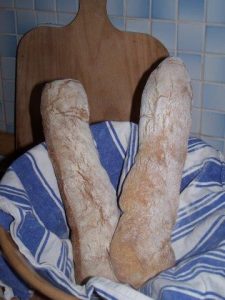
Pane francese is italian and means french bread. It is the Italian version of baguette. Having the look of a ciabatta, the crumb is similar to a baguette.
It is a very tasty bread with a rustic look, that contains a small amount of whole wheat flour and such a minimal amount of yeast, that I really doubted that the dough would rise. But never underestimate these small creatures. The long fermentation period give them enough time to proliferate and the bread had a nice oven spring.
Pane Francese
Yield 8 loaves of 250g
Poolish:
- 250g Water
- 250g flour (Typ 550)
- 1g yeast
Dough:
- 800g flour (Typ 550)
- 200g whole wheat flour
- 750g water
- 25 g salt
- 1g yeat
Mix water, flour and yeast for the poolish and ferment it overnight (10 to 12 hours).
The next mornig: Knead flour, 700g water and poolish untill it is homogeneus (aroung 1 min). Let rest for 1/2 hour (Autolysis). In the meantime disolve the yeast in the remaing water.
After Autolysis: Knead the dough for 5 min, now add the salt and the yeast-water in small portions. Wait untill one portions is complete incorporated before adding the next one.
The dough is a little bit sticky now, but that is ok.
Now place the dough in a good oiled container and ferment for 3 hours. Give the dough three folds during this time.
Folding: Flour your countertop and put the dough on it. Flat the dough carefully to a square. Now fold the right and the left side to the middle, then from button and top, too. You can find a nice tutorial here.
After proofing flat the dough carefully to a square (around 3 cm thick), cover the surface with flour and cut it in 8 Strips. Strech each stripe to a length of 35 cm.
Proof them for 45 min.
In the meantime heat baking stone in the oven to 250°C.
Bake the loaves on the hot stone for 25 min with steam, until the crust is golden brown.
Wer viele beeindruckende Brote sehen möchte, sollte Susans wöchentliches Yeastspotting besuchen.
Deutsch



Wann kommt denn der gemahlene Weizen dazu?
@Claudia: Der fällt für mich auch unter Mehl, kommt also mit dem hellen Weizenmehl zusammen in den Teig. Ich gebe aber zu, dass das verwirren kann und überlege mir eine neue Formulierung! 🙂
Pingback: Hefe und mehr » Blog Archive » Pane Pugliese – BBD#32
Ja, ist schon erstaunlich wie sich die kleinen Hefen so vermehren, um ein Brot locker werden zu lassen
I love the rustic look of these loaves!